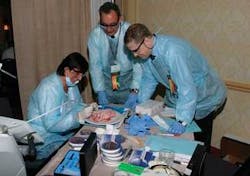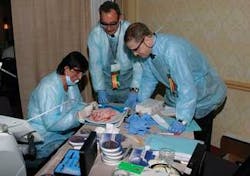Dental laser training vs. certification
by Gail S. Siminovsky, CAE
This is the first in a series on laser dentistry. Throughout the series we will discuss considerations before purchasing a laser, common uses, practitioner and patient benefits, regulatory issues, resources, training, certification, and continuing education. Before buying a laser, clinicians should attend national meetings where lasers are being presented and attend an introductory course. Once you’ve purchased a laser, participate in a manufacturer-sponsored training course and Academy of Laser Dentistry (ALD) certification courses. The education you need includes a healthy mix of corporate-sponsored training and courses offered by professional associations. ALD, representing safe laser use in dentistry, is the only professional association with a well-balanced certification program recognized by organized dentistry.
Laser dentistry is primarily performed in private practice settings. Dentists and dental hygienists use lasers for up to 24 specific indications, ablation of enamel, dentin and bone, and gum surgery. Most lasers are used one to five times a day. The educational standards within the dental profession - defined in the Curriculum Guidelines and Standards for Dental Laser Education - have been endorsed worldwide and implemented by ALD. The standards also include the implementation of ANSI Z136.3 Safe Use of Lasers in Health Care Facilities in the dental treatment environment. Professionals are encouraged to follow the recommendations of organized laser dentistry for specific training and certification before using lasers on patients.
The difference between training and certification
To assure safe and efficacious use of lasers for the health and welfare of patients, ALD manages a certification program to demonstrate understanding of safe laser use. Introductory courses offer general information but do not assess proficiency. Standard Proficiency courses offer instruction with hands-on exercises and a clinical simulation proficiency examination. This course must be satisfactorily completed before using lasers independently. This level of education has been defined as the educational standard. Advanced Proficiency represents advanced knowledge and clinical experience with the dental laser and is administered only by ALD at its annual meeting. The fourth level of education on dental lasers is the Educator course, which provides specific instruction in planning and presenting the Standard Proficiency course.
Many laser manufacturers have training programs to support their customers. It is important to participate in these programs to become familiar with the proper mechanisms of the device you will use every day. Biolase Technology sponsors the World Clinical Laser Institute. Hoya Conbio developed the College of Clinical Laser Dentistry to train its customers. Lumenis calls its training programs the Symphony of Light. Lares Research has a training CD as well as in-office training. Incisive, Ivoclar, Syneron, Sirona, and Zap Lasers each provide introductory courses and laser training. While important, these programs are not certification-recognized by the profession.
As a purchaser, ask if the manufacturer participates in ALD Standard Proficiency certification. Many companies may not make this distinction clear in their marketing and sales efforts. In manufacturer training programs, the company’s interests are clearly defined as a business interest with existing and potential customers. The distinction between commercial marketing, sales and training, and a professional educational standard is important. ALD is the standard bearer for certification in laser dentistry as the profession’s independent unbiased organization. Be aware of this distinction. Use caution when you determine whether or not taking manufacturer training courses is sufficient for the professional services you provide to patients daily.
At this time, there is little state regulation relative to the use of lasers in dentistry. Some states are beginning to implement requirements for relicensure that include certification programs defined by ALD.
Standard proficiency in dentistry
Any Standard Proficiency course recognized by ALD includes lecture and hands-on instruction of at least 12 hours, a 75-question exam, and a clinical simulation proficiency exam. Clinicians and auxiliaries must demonstrate proper safe use by clinical simulation with appropriate oral tissues (e.g., cow or pig jaws). Through ALD, continuing-education courses at the Standard Proficiency level are evaluated and must meet specific criteria to be recognized through ALD’s Standard Proficiency Course Provider Recognition program. After completing the clinical simulation proficiency exam, participants may obtain certification by successfully taking the online standard proficiency multiple choice exam and joining ALD.
The online multiple choice exam tests overall laser knowledge, the nature and production of laser light, laser physics, laser types and components of laser devices, tissue interaction, clinical applications, regulations, and safety. Successful participation is important to clinicians’ overall success in using lasers safely. The passing score is 75 percent.
The clinical simulation proficiency exam tests three areas, each with a specific criteria for assessment. The passing score is 75 percent.
1) Knowledge of the device and overall safety - During the exam, the participant must identify on a specific laser up to eight safety mechanisms such as the on/off switch, guarded footswitch, emergency stop diagnostic software, system time-out, and fiber detectors. He or she must also identify the necessary safety aspects of the environment, such as identification of the controlled area, proper posting of signs outside the nominal hazard zone, limited access, and minimization of reflective surfaces. The exam includes discussion about minimizing access and traffic through the nominal hazard zone. General anesthesia and intubation are not common in laser dentistry, but nitrous oxide and oxygen use with lasers are common provided there is proper evacuation. Examinees then must identify proper protective eyewear specific for the wavelength laser being used with proper side shields that are worn by the dentist, patient, and staff within the nominal hazard zone. The last item assessed in this portion of the exam is the description of the FDA’s Adverse Effects reporting mechanism. Each dental office must have a designated Laser Safety Officer (LSO) to supervise proper use of lasers and coordinate staff education/training. The LSO oversees personal protective wear (e.g., appropriate eyewear) and knows regulations, including any specific state regulations.
2) Infection control, general setup procedures, operating parameters - In this portion of the clinical exam, the clinician actually sets up the laser and assembles the delivery system, typically a fiber and handpiece and tips. The examinee test-fires the laser and then chooses low and high settings for two separate dental procedures. He or she then describes proper infection control with high-volume evacuation, contaminated and uncontaminated zones, as well as proper cleaning and sterilization procedures.
3) Patient management - The clinician discusses the specific indications for laser use by providing a treatment proposal and demonstrates specific treatment objectives. For instance, if the clinician is using an ErCr:YSGG or Er:YAG laser for hard tissue, he or she would do a simple cavity preparation. The surgical technique is achieved on the teeth in a hog jaw with the clinician ablating the enamel and dentin. To be successful, clinicians must assure proper operating parameters of power, repetition rate, energy density, and air/water spray to remove enamel and dentin. The clinician simulates the procedure on the hog jaw and describes proper patient management and management of complications. Lastly, he or she describes surgical and healing assessment methods and the interval for the demonstrated procedure on a scale of excellent, good, fair, and poor.
In 2007, national meetings offering dental laser education include ALD’s annual session in March (Nashville), the Academy of General Dentistry in June (San Diego), and the ADA annual session in September (San Francisco). For those truly serious about laser use, investigate professional scientific meetings like SPIE, International Society for Laser Dentistry (ISLD), and ALD’s Advanced Proficiency program.References available upon request.
Gail Siminovsky, CAE, is the executive director of the Academy of Laser Dentistry. She is a member of the American Society of Association Executives, Florida Society of Association Executives, American Association of Dental Editors, National Coalition of General Dental Organizations, and National Council of Dental Credentialing Organizations. Siminovsky may be reached by e-mail at [email protected].
Helpful links
Laser training courses and study materials are readily available ...
- Source 2007: Academy of Laser Dentistry Annual Conference, March 28-31, 2007 -
http://www.source2007.org - Dental laser manufacturers-
http://www.laserdentistry.org/os_corporate.cfm - Register for an online course or examination -
http://www.laserdentistry.org/prof/edu_certprog_geninfo.cfm - Certification in laser dentistry-
http://www.laserdentistry.org/prof/edu_certprog_geninfo.cfm - Standard proficiency recognized course providers-
http://www/laserdentistry.org/prof/idu_cert_courseprov.cfm - Dental laser courses -
http://www.laserdentistry.org/prof/edu_dentallasercourses.cfm#resource - Suggested resources -
http://www.laserdentistry.org/prof/edu_publications_resources.cfm#readingsvideo - Curriculum guidelines/standards for dental laser education -
http://www.laserdentistry.org/prof/edu_curriculumguidelines.cfm - Laser Institute of America - ANSI Z136.3 - Safe Use of Lasers in Health-Care Facilities -
http://www.laserinstitute.org/store/ANSI/113

